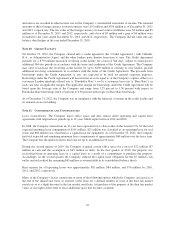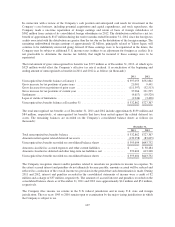Yahoo 2012 Annual Report Download - page 111
Download and view the complete annual report
Please find page 111 of the 2012 Yahoo annual report below. You can navigate through the pages in the report by either clicking on the pages listed below, or by using the keyword search tool below to find specific information within the annual report.June 2010 and May 2012 stock repurchase programs at an average price of $17.20 per share for a total of $2.2
billion. The June 2010 program was exhausted during 2012. As of December 31, 2012, the May 2012 program
had remaining authorized purchase capacity of $3.4 billion.
During the year ended December 31, 2011, the Company retired 82 million shares, resulting in reductions of $82
thousand in common stock, $643 million in additional paid-in capital, and $559 million in retained earnings.
During the year ended December 31, 2012, the Company retired 79 million shares, resulting in reductions of $79
thousand in common stock, $631 million in additional paid-in capital, and $585 million in retained earnings.
Treasury stock is accounted for under the cost method.
Note 13 E
MPLOYEE
B
ENEFITS
Benefit Plans. The Company maintains the Yahoo! Inc. 401(k) Plan (the “401(k) Plan”) for its full-time
employees in the U.S. The 401(k) Plan allows employees of the Company to contribute up to the Internal
Revenue Code prescribed maximum amount. Employees may elect to contribute from 1 to 50 percent of their
annual compensation to the 401(k) Plan. The Company matches employee contributions at a rate of 25 percent,
up to the IRS prescribed amount. Both employee and employer contributions vest immediately upon
contribution. During 2010, 2011, and 2012, the Company’s contributions to the 401(k) Plan amounted to
approximately $21 million, $20 million, and $19 million, respectively. The Company also contributed
approximately $23 million, $24 million, and $22 million to its other defined contribution retirement benefit plans
outside of the U.S. for 2010, 2011, and 2012, respectively.
Stock Plans. The 1995 Stock Plan provides for the issuance of stock-based awards to employees, including
executive officers, and consultants. The 1995 Stock Plan permits the granting of incentive stock options, non-
statutory stock options, restricted stock, restricted stock units, stock appreciation rights, and dividend equivalents.
Options granted under the 1995 Stock Plan before May 19, 2005 generally expire 10 years after the grant date,
and options granted after May 19, 2005 generally expire seven years after the grant date. Options generally
become exercisable over a four-year period based on continued employment and vest either monthly, quarterly,
semi-annually, or annually.
The 1995 Stock Plan permits the granting of restricted stock and restricted stock units (collectively referred to as
“restricted stock awards”). The restricted stock award vesting criteria are generally the passing of time, meeting
certain performance-based objectives, or a combination of both, and continued employment through the vesting
period (which varies but generally does not exceed four years). Restricted stock award grants are generally
measured at fair value on the date of grant based on the number of shares granted and the quoted price of the
Company’s common stock. Such value is recognized as an expense over the corresponding service period.
The 1995 Stock Plan provides for the issuance of a maximum of 754 million shares of which 109 million shares
were still available for award grant purposes as of December 31, 2012. Each share of the Company’s common
stock issued in settlement of “full-value awards” (which include all awards other than options and stock
appreciation rights) granted on or after June 25, 2009 under the 1995 Stock Plan is counted as 1.75 shares against
the 1995 Stock Plan’s share limit.
The Directors’ Plan provides for the grant of nonqualified stock options and restricted stock units to non-
employee directors of the Company. The Directors’ Plan provides for the issuance of up to 9 million shares of the
Company’s common stock, of which approximately 5 million were still available for award grant purposes as of
December 31, 2012. Each share of the Company’s common stock issued in settlement of restricted stock units
granted after the Company’s 2006 annual meeting of shareholders under the Directors’ Plan is counted as 1.75
shares against the Directors’ Plan’s share limit.
Options granted under the Directors’ Plan before May 25, 2006 generally become exercisable, based on
continued service as a director, for initial grants to new directors, in equal monthly installments over four years,
97
























